Click to Skip Ahead
The toy poodle is the smallest version of the three recognized Poodle classifications. These tiny pups are built to be companions and make excellent lightweight lap dogs, weighing only 4 to 6 pounds when fully grown. Poodles come in a range of coat colors, with white being one of the most popular.
Breed Overview
Height:
Under 10 inches
Weight:
6 to 9 pounds
Lifespan:
14 to 16 years
Colors:
White, cream, brown, black, apricot, silver, red
Suitable for:
Families with older kids, apartments, houses, many different types of people
Temperament:
Lively, loving, playful, energetic, intelligent
The white toy poodle has been around since the breed’s beginnings and has grown in popularity over the years. Nowadays, these precious little pooches are consistently ranked as one of the most popular toy breeds in the nation and are used in the creation of many designer dog breeds.
Toy Poodle Characteristics
The Earliest Records of White Toy Poodles in History
Though the origin of the poodle has been debated between France and Germany, it has been well established that they most likely originated in Germany as water dogs. The name poodle is derived from the German word “pudel,” “which means “to splash in the water.”
Regardless of origin, the Poodle was first used to retrieve waterfowl and other game alongside hunters throughout Europe. Their intelligence, athleticism, and obedient nature led breeders to produce smaller versions of the breed, which ultimately led to the Miniature Poodle, referred to as the toy poodle until 1907.
These smaller dogs were much easier to travel with and performed well in the circus for traveling venues. The white toy poodle that we know and love today did not exist until the 20th century when they bred the breed down even smaller.
At first, many birth defects, health issues, and behavioral concerns were common in the toy poodles until more strict breeding practices were implemented. Eventually, the toy poodle was perfected into a healthy, well-rounded replica of the larger poodles.
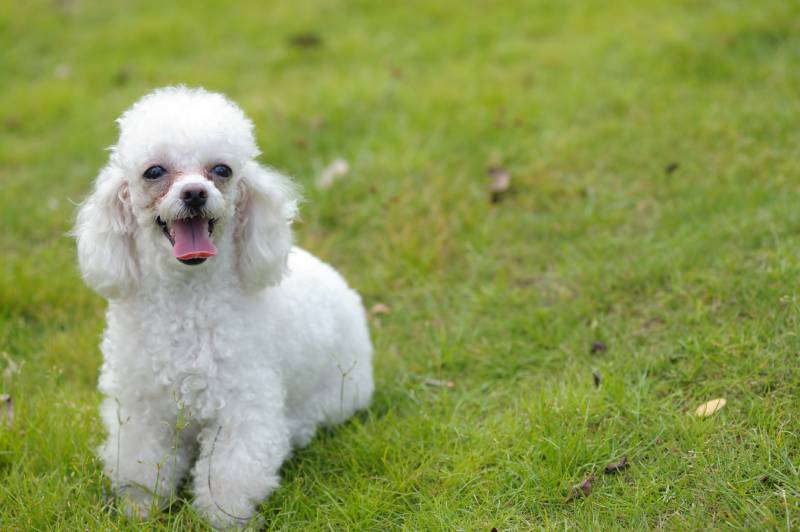
How the White Toy Poodle Gained Popularity
The poodle’s popularity began to soar in America around 1935 after a poodle won Best in Show at Westminster, which the breed has done a total of 10 times since. Their popularity soared even more from the 1960s through the 1980s when many prominent public figures openly owned and showed off their beloved poodles of all sizes.
To this day, white toy poodles and many other coat colors and patterns remain a very popular companion breed thanks to their loving, devoted, and friendly nature. They are also extremely popular among allergy sufferers since they do not shed. These pups are so popular that they’ve gone on to develop some of the most popular designer hybrid breeds, too.
Formal Recognition of the White Toy Poodle
The Poodle was first recognized by the Kennel Club of the United Kingdom in 1874. The Toy Poodle, along with the Miniature and the Standard were all formally recognized by the American Kennel Club in 1887. Recognition of this popular breed was established shortly after these clubs were founded.

Top 10 Unique Facts About White Toy Poodles
1. There Are Three Types of Poodles but Only One Breed Standard
There are three recognized poodle types: the Toy Poodle, the Miniature Poodle, and the Standard Poodle. While they may come in different sizes, each variety is held to the same breed standard.
2. The Classic Poodle Haircut Serves a Purpose
Rather than being a distinct fashion trend for the breed, the classic poodle cut is meant to increase functionality in the water. The areas where the hair is cut short help increase a poodle’s speed in the water, while the thick puffy areas help protect their vital organs and joints from the cold water.
3. White Toy Poodles Have Hair, Not Fur
Poodles are unique in that they have hair rather than fur, like most other dogs. Fur grows to a certain point and then is shed, while hair continuously grows. A poodle’s hair is sensitive to hormonal fluctuations and females have even been known to experience hair thinning or loss after whelping, much like humans can.
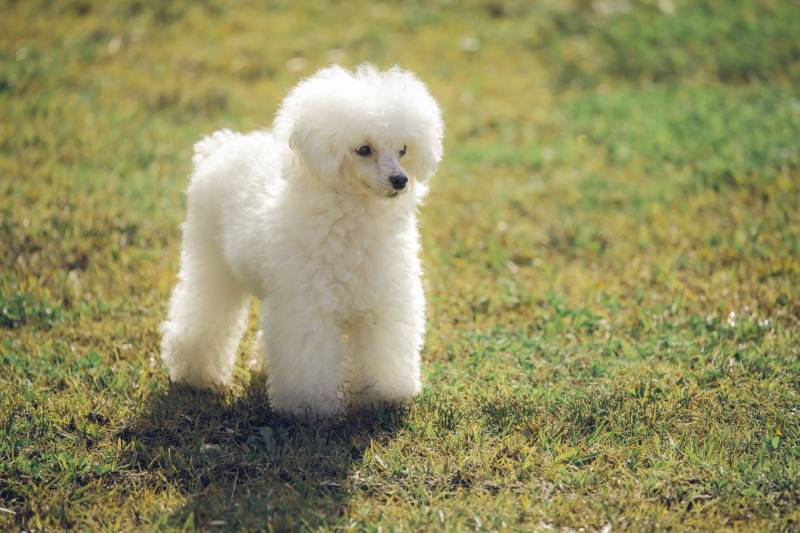
4. Many Famous People Have Owned Poodles
Plenty of big-name celebrities have chosen the Poodle as their go-to breed. This list includes Walt Disney, Jackie Kennedy, Elizabeth Taylor, Lucille Ball, Katherine Hepburn, and Marilyn Monroe. While we don’t need any celebs to convince us how great the breed is, they certainly have a reputation among the rich and famous.
5. Many Designer Toy Breeds Are Created with Toy Poodles
There are plenty of popular pedigreed toy breeds for small dog lovers to choose from, but designer hybrids breeds have been growing in popularity over the years to bring out the best traits of both parent breeds and fewer genetic health concerns. Toy poodles contribute to many designer breeds like the Cockapoo, Yorkipoo, Pomipoo, Schnoodle, Peekapoo, Shihpoo, and more.
6. Their Origin Is Heavily Debated
Poodles may be France’s national dog and were always thought to have originated in the country as water dogs however, it is debated that the breed originated in Germany as hunting dogs that were used to retrieve waterfowl. Granted, the toy poodles came a bit later when selective breeding took place to make a more size-friendly version of the breed.
7. They Are High Maintenance
It may come as no surprise that these elegant dogs may be a bit more on the high-maintenance side. Their unique coats require regular grooming to prevent tangles or mats. Unlike a lot of other breeds, poodles do not shed, and their hair will continue to grow, a grooming session once every 6 to 8 weeks is generally the recommendation. It’s also important to keep up with regular tooth brushing to prevent plaque build-up. Smaller dogs are highly susceptible to dental disease and proper hygiene is an important preventative measure.
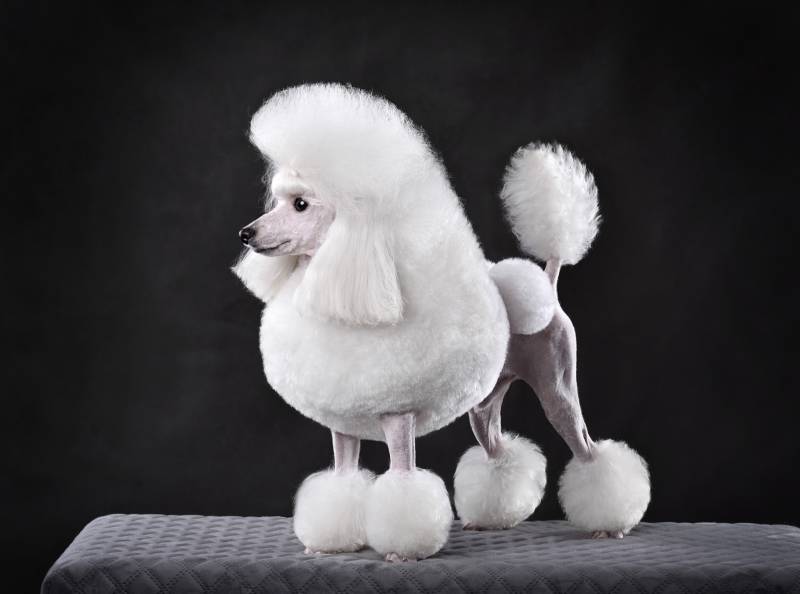
8. White Toy Poodles Are Incredibly Intelligent
Poodles are a very intelligent breed, and you can surely expect that your tiny white toy poodle will be a smart cookie in a small package. These dogs are alert, responsive, lively, and eager to please, making them easy to train. They are very devoted to their owners and will genuinely enjoy the challenges and rewards of positive reinforcement training.
9. They Require Regular Exercise but Less Space
A white toy poodle is still very much a poodle. Although they may not have the size of the standard poodle and were bred for companionship, they do have daily exercise requirements that need to be met. Owners should expect to set aside around 60 minutes per day for this breed to expend their energy and get in some needed physical and mental stimulation. The good news is, they don’t require nearly as much space as their larger counterparts.
10. They Can Make Great Watchdogs
Toy poodles may be incredibly friendly, but they can be a bit territorial and may not come off that way with strangers. If a Toy Poodle hears anything unusual or suspects anything out of the ordinary, you can expect to be alerted. They are prone to excessive barking, so it is recommended to start training at an early age to get control.
 Do White Toy Poodles Make a Good Pet?
Do White Toy Poodles Make a Good Pet?
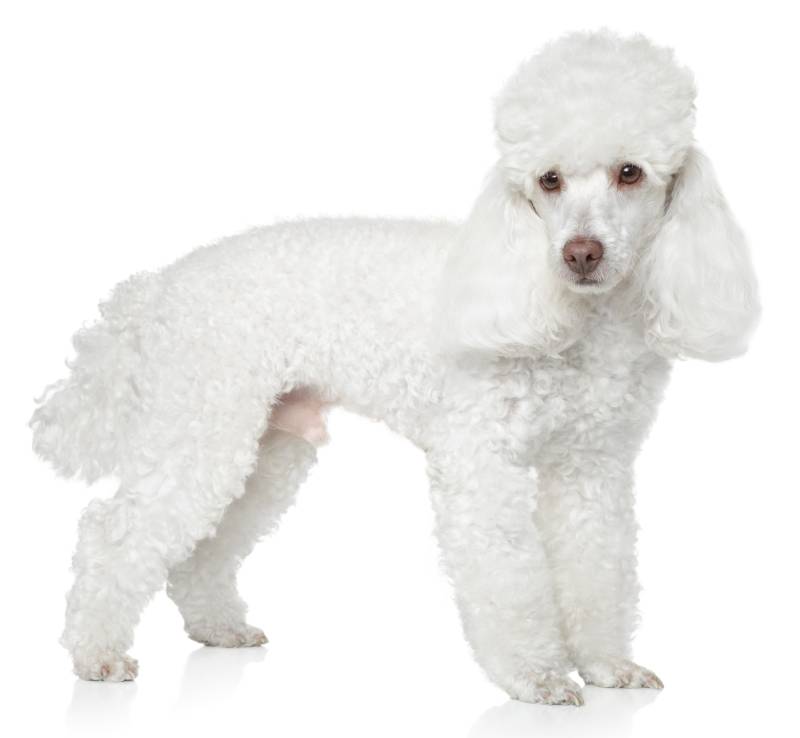
Toy poodles fit the criteria for being the ideal family dog. Unlike some other toy breeds that have less tolerance for young children, these dogs are known for being great with little ones. Of course, this is based on the individual dog, and one should always remain cautious with any dog around small children.
Not only are they very loving and affectionate, but they are also small and easy to train. Their intelligence and eagerness to please were one of the reasons breeders selectively bred them into this tiny, toy size.
While no dogs can technically be considered hypoallergenic, since poodles have hair as opposed to fur like most dogs, they are much more allergy-friendly and are extremely popular among dog lovers who suffer from allergies.
These little tikes require a good amount of activity and mental stimulation to prevent them from becoming bored and destructive. They will need to get in their daily dose of activity to thrive. Something to consider is that white toy poodles are very attached to their family and do not do well when left alone. This is a breed that commonly suffers from separation anxiety.
Toy poodles do best when given a routine, they don’t do too well in households with lots of chaos. They have the potential to make wonderful pets if owners are prepared to meet their physical, mental, and higher-maintenance grooming needs.
In Conclusion
The white toy poodle is one of the many coat color variations of the beloved toy poodle. The poodle breed is among the most popular dog breeds that have been around for centuries. They were selectively bred into three different recognized size varieties so that dog owners could enjoy the wonderful qualities of the breed in a size that suits them best.
See also:
- White Poodle: Facts,Pictures, History & Origin
- Dutch Shepherd Dog Breed: Info, Pictures, Personality & Care
Featured Image Credit: michaelheim, Shutterstock

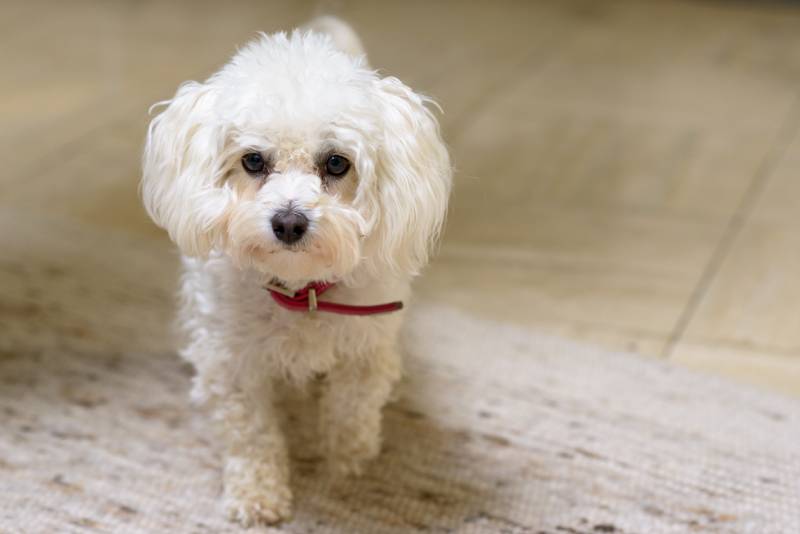


 Do White Toy Poodles Make a Good Pet?
Do White Toy Poodles Make a Good Pet?







